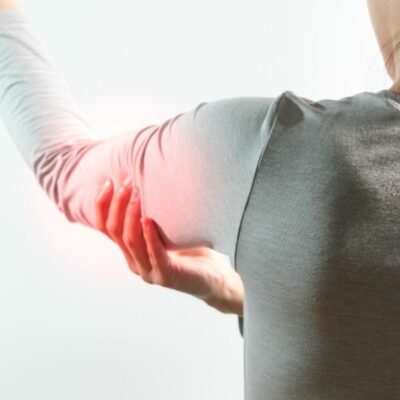Distal Triceps Tear Specialist

Are you an athlete who participates in a sport which causes a repetitive load during elbow extension, such as a football lineman or a weightlifter? If so, you may be at risk of sustaining a distal triceps tear. Distal triceps tears can also occur from a fall on an outstretched arm. Distal triceps tear specialist, Dr. James Mazzara provides diagnosis and both surgical and nonsurgical treatment options for patients in Manchester, South Windsor, Enfield, Glastonbury and surrounding Hartford communities who have suffered a distal triceps tear. Contact Dr. Mazzara’s team today!
Distal Triceps Tear – Triceps Tendon Rupture
What is a distal triceps tear?
The triceps muscle includes three heads–thus the name, “tri-ceps”. The long head muscle begins at the scapula (shoulder blade) and the medial and lateral head of the muscle begin at the proximal humerus (top and back of the arm bone.) These three muscle “heads” join together at the elbow and attach to the olecranon (bony/pointy part of the elbow) forming one of the strongest tendons in the body. Distal triceps tears, also known as a distal triceps rupture, is uncommon. It may be seen in weight lifters, body builders and football players, but may also be seen in work-related injury. A distal triceps tear is almost always traumatic and requires a significant amount of force.
The injury usually involves a force that suddenly bends the elbow while the muscle is trying to straighten it. Dr. James Mazzara, elbow specialist in Manchester, South Windsor, Enfield, Glastonbury and surrounding Hartford communities has extensive experience in treating distal triceps ruptures.
Who is susceptible to a distal triceps rupture?
While tears of the distal triceps tendon are not common, they are receiving increasing attention. The modern athlete may be predisposed to a distal triceps tear, especially football linemen, weightlifters or athletes with repetitive load during elbow extension. The non-athlete population who have experienced a distal triceps tear involve those who have fallen on an outstretched hand or received a blunt trauma. Factors that weaken the tendon and increase the risk of tear include local corticosteroid injection, systemic steroids, and olecranon bursitis.
What are the symptoms of a distal triceps tear?
- Feeling or hearing a “pop” in the elbow
- Pain, immediately with the injury, can be intense, and will improve after several days
- Bruising and swelling at the back of the elbow and upper arm
- Weakness and the inability to straighten the elbow against resistance
- Defect above the olecranon (at the tip of the elbow) where the rupture can sometimes be felt
How is a distal triceps rupture diagnosed?
Dr. Mazzara will ask for a complete patient history, along with the symptoms and mechanism of injury. A thorough exam with an ultrasound may be required. Further diagnostic testing may involve an x-ray to make sure there is no bone injury and an MRI to confirm the diagnosis.
How is a distal triceps tear treated?
Treatment of a distal triceps tear depends on several factors including the patient’s age, expected outcome and degree of the tear. Some partial tears can be managed non-surgically, while full or complete tears require surgical repair.
Primary repair of the torn triceps tendon is possible within the first three weeks after injury. It is important to consult with Dr. Mazzara and his orthopedic team soon after initial injury. Delayed diagnosis may necessitate reconstruction, which is more complex and can have a longer period of recovery.
If Dr. Mazzara decides that surgery is the best option for the patient, he will make an incision over the back of the elbow to expose the ruptured tendon and repair it to the bone. The repair involves placing strong sutures into the tendon and anchoring them to the olecranon.
Healing requires immobilization of the elbow for several weeks to prevent stress on the repair. As with most tendon repairs, the tendon needs to heal in the repaired position. Motion exercises are started slowly over many weeks. Once full range of motion has been restored, strengthening of the triceps muscle and other supporting muscles can begin. It is important for the patient to follow Dr. Mazzara’s physical therapy protocol to achieve full healing and a return to normal activities.
If you would like more information about a distal triceps tear, please contact the orthopedic office of Dr. James Mazzara, elbow specialist serving patients living in Manchester, South Windsor, Enfield, Glastonbury and surrounding Hartford Connecticut communities.
